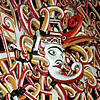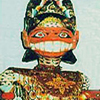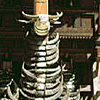 |  |  |
The Culture and Art
Indonesia is rich in art and culture which are intertwined with religion and age-old traditions from the time of early migrants with Western thoughts brought by Portuguese traders and Dutch colonists. The basic principles which guide life include the concepts of mutual assistance or "gotong royong" and consultations or "musyawarah" to arrive at a consensus or "mufakat" Derived from rural life, this system is still very much in use in community life throughout the country.
Though the legal system is based on the old Dutch penal code, social life as well as the rites of passage are founded on customary or "adat" law which differs from area to area. "Adat" law has a binding impact on Indonesian life and it may be concluded that this law has been instrumental in maintaining equal rights for women in the community. Religious influences on the community are variously evident from island to island.
Unlike some countries art forms in Indonesia are not only based on folklore, as many were developed in the courts of former kingdoms such as in Bali, where they are part of religious ceremonies. The famous dance dramas of Java and Bali are derived from Hindu mythology and often feature fragments from the Ramayana and Mahabharata Hindu epics.
Highly stylized in movement and costume, dances and the "wayang" drama are accompanied by a full "gamelan" orchestra comprising xylophones, drums, gongs, and in some cases string instruments and flutes. Bamboo xylophones are used in North Sulawesi and the bamboo "angklung" instruments of West Java are well- known for their unique tinkling notes which can be adapted to any melody.
The "Wayang kulit" (leather puppets) of Java is performed with leather puppets held by the puppeteer, who narates the story of one of the famous episodes of the Hindu epics, the Mahabharata or the Ramayana. It is performed against a white screen while a lantern in the background casts the shadows of the characters on the screen, visible from the other side where the spectators are seated.
The "Wayang Golek" (wooden puppets) of West Java is based on the same concept. The crafts of Indonesia vary in both medium and art form. As a whole the people are artistic by nature and express themselves on canvas, wood, metals, clay and stone. The batik process of waxing and dyeing originated in Java centuries ago and classic designs have been modified with modern trends in both pattern and technology. There are several centres of Batik in Java, the major ones being Yogyakarta, Surakarta, Pekalongan and Cirebon.
Batik is also being produced in some other areas as in Bali where local designs are incorporated. Other provinces produce hand-woven cloths of gold and silver threads, silks or cottons with intricate designs. Painting are numerous all over the country, both traditional and contemporary, woodcarvings for ornamentation and furniture, silverwork and engraving form Yogyakarta and Sumatra, filgree from South Sulawesi and Bali with different styles of clay, sandstone and wood sculptures. These are but a few of the handicrafts found in Indonesia.
 10:09 AM
10:09 AM
 admin
admin

 Posted in:
Posted in: 

0 comments:
Post a Comment